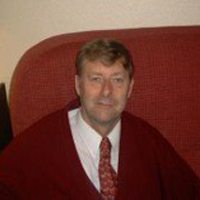Govert Westerveld, (Monnickendam (Holanda), 1947), es un antiguo campeón
juvenil de Holanda del juego de damas, cronista oficial de la villa de Blanca
(Murcia), hispanista, historiador e investigador independiente.
Se estableció en 1974 en España y fue socio co-fundador de la empresa
Zoster S.A. de extractos naturales. Otros socios fueron Francisco Sabater
García (rector de la Universidad de Murcia 1975-1980), José Antonio Lozano
Teruel (rector de la Universidad de Murcia 1980-1984), varios químicos y
algunos hombres de negocios. Este negocio se vendió a Carlos Ferrer Salat,
ex-presidente entre 1987-1998 del Comité Olímpico Español. En 1989 fundó
Westerveld la empresa Natura Internacional S.L. como consultor de exportación y
nuevos productos.
Westerveld publicó en 1994 y 1997 sus trabajos sobre la influencia de la
Reina Isabel la Católica en la nueva dama poderosa, rompiendo así el mito de
otros historiadores internacionales de que el juego de Damas fuera un invento
francés y la nueva dama en el ajedrez un logro italiano ó francés. Desde
entonces centra sus trabajos de investigación por completo sobre la historia
del pueblo de Blanca. En 2002 fue elegido Cronista oficial de Blanca, junto a
su amigo Ángel Ríos Martínez. En el mismo año fue elegido Académico
Correspondiente de la Real Academia Alfonso X el Sabio de Murcia, teniendo
en cuenta los méritos de su persona en relación con la cultura de la Región de
Murcia.
En 2004, la Generalidad Valenciana edita su obra "La reina Isabel la
Católica: su reflejo en la dama poderosa de Valencia, cuna del ajedrez moderno
y origen del juego de damas", libro en la cual participa activamente el
historiador ajedrecístico José Antonio Garzón Roger. Éste último confirmó la
hipótesis de “Isabel la Católica” y halló la prueba documental en Scachs
d'amor, con revelaciones de gran repercusión nacional y mundial. En 2005 fue
elegido Miembro de la Asociación Internacional de Hispanistas, Las
investigaciones de Garzón y Westerveld merecieron el reconocimiento a todo
nivel, tanto que hasta el mismo Luis Suárez Fernández, el máximo especialista
sobre Isabel La Católica, que lleva estudiándola más de 50 años, escribió sobre
estas investigaciones. En 2006 Westerveld (firmado con el seudónimo Godofredo
Valle de Ricote) aclara definitivamente la verdadera biografía del desconocido
ajedrecista Juan Ramírez de Lucena, padre de Lucena y embajador de los Reyes
Católicos, precisando finalmente con esta obra, en la que incluye árboles
genealógicos que Lucena no es Luis de Lucena como erróneamente dicen casi todos
los historiadores, sino simplemente Lucena tal como correctamente señala
Ricardo Calvo en (1997) y consta en el libro de ajedrez del año 1497. Publica
tres libros más entre 2007 y 2009 sobre La Celestina, gravitando en ellos como
hipótesis principal que el libro La Celestina no fue escrito por Fernando
Rojas, sino por Juan del Encina. Por otra parte, después de una considerable
investigación, tiene la tesis de que Francisco Delicado, Bartolomé Torres
Naharro y Hernando del Castillo son los seudónimos de Juan del Encina.
En 2006 Westerveld, se adentra en el terreno de los expertos del tema
morisco con una compleja investigación cuyo corolario es que el Morisco Ricote
no es natural de Esquivias ni de Albacete como afirman los historiadores, sino
del Valle de Ricote. En 2010 el gran especialista en el tema de los moriscos,
Prof. Dr. Francisco Márquez Villanueva, confirma en su nuevo libro del año 2010
la hipótesis de Westerveld. En 2008, Westerveld culmina su hipótesis de que el
cambio de nombre del pueblo de Negra a Blanca se efectuó entre 1353 – 1362 y
que el nuevo nombre estaba basado en la reina Blanca de Borbón, esposa legítima
del Pedro Cruel. Desde los años ochenta tiene como hipótesis que Antonio de
Torquemada nunca escribió el primer libro del juego de las Damas, atribución
generalizada entre los historiadores. Otra vez pudo confirmar José Antonio
Garzón Roger mediante profundas investigaciones y documentos la certeza de las
ideas de Westerveld, localizando el error bibliográfico. El 25 de abril de
2012, Garzón fue galardonado con el ‘Premio al Mérito Deportivo Ciudad de
Valencia’ por sus importantes hallazgos históricos de ajedrez. En septiembre de
2009 participó Westerveld en el Simposio Internacional de Historia y Cultura
del Ajedrez “Valencia Cuna del Ajedrez Moderno”, que se celebró en el marco del
encuentro Karpov-Kasparov, y pudo situarse entre los especialistas
contemporáneos en Historia del ajedrez, acreditándose el origen valenciano del
ajedrez moderno.
Merecen destacarse sobremanera dos de sus grandes aportaciones: de un lado,
que la dama del ajedrez no es sino el reflejo, en el pequeño tablero de madera,
de la gran reina Isabel la Católica; de otro, que el juego de damas deriva,
nace, en España (Valencia), precisamente del ajedrez moderno, tal es su
aceptación, recién instaurado pocos años antes. Westerveld es un historiador
oficial de la Federación Mundial del Juego de Damas y tanto Garzón como él son
miembros oficiales de la Comisión de Historia de la Federación Española de
Ajedrez.
English
Govert Westerveld,
(Monnickendam - The Netherlands, 1947), is a former Draughtsplayer, official
Historian of the village Blanca, situated in the Ricote Valley in the Region of
Murcia. He is Hispanist, Historian and Researcher of Alquerque, Chess,
Draughts, La Celestina, Moriscos and the Spanish Civil War. In 1962, he beated
Ton Sijbrands from Amsterdam and won with 15 years the Dutch Youth Championship
of Draughts. Before retiring in his daily work he was expert in Competitive
Intelligence, Innovative Entrepreneur and Researcher of new foreign markets. He
established himself in 1974 in Spain and was a founder member of Zoster S.A., a
Company of natural extracts. Other shareholders were Francisco Sabater
García (rector of the University of Murcia 1975-1980), José Antonio Lozano
Teruel (rector of the University of Murcia 1980-1984), various chemists and
some business men. In 1989, the founders sold this firm to Carlos Ferrer
Salat, ex-president from 1987-1998 of the Spanish Olympic Committee.
Westerveld published in 1994
and 1997 his works on the influence of the Queen Isabella I of Castile on the
new powerful Dama, breaking the myth of other international historians that the
Draughts game was a French invention and that the new powerful Dama in Chess
was an Italian or French achievement. Since then, his research focused on the
history of the town of Blanca, Murcia. In 2002, the village Blanca, Murcia
elected him as Official Chronicler, together with his friend, Angel Rios
Martinez. In the same year, the Real Academia Alfonso X el Sabio at Murcia elected
him as Fellow, taking into account the merits of his work in relation to
the culture of the Region of Murcia.
In 2004, the Valencian
Community released his book "Queen Isabella: her reflection on the
powerful Dama of Valencia, the birthplace of Modern Chess and origin of
Draughts”, a book in which the chess historian Jose Antonio Garzon Roger
participated actively. The latter confirmed the hypothesis of
Isabella I of Castile and found the documentary evidence in Scachs
d'amor, with revelations of important national and global impacts. In 2005,
the International Association of Hispanists, elected him as
Hispanist. Garzon's and Westerveld’s investigations deserved
recognition at all levels, so that even Professor Luis Suárez Fernández, the
top expert on Isabelle I of Castile (Isabella the Catholic Monarch), who had
been studying her for over 50 years, wrote about these investigations. In 2006,
Westerveld (signed with the pseudonym Godofredo Valle de Ricote) definitively
clarifies the real biography of the unknown chess player Juan Ramirez de
Lucena, father of Lucena and Ambassador of the Catholic Monarchs. He is finally
requiring with this work, which includes family trees, that Lucena is not
Luis de Lucena as erroneously stated by almost all historians, but just Lucena
as Ricardo Calvo accurately noted in (1997), because so it is recorded in the
Chess Book of 1497. Westerveld published three books between 2007 and 2009 on
La Celestina, weighing in them as essential thesis that Fernando Rojas did not
write the book La Celestina, but Juan del Encina. Moreover, after considerable
research he has the thesis that Francisco Delicado, Bartolomé de Torres
Naharro and Hernando del Castillo are pseudonyms for Juan del Encina.
In 2006, Westerveld, delves into the realm of experts of the
Morisco theme with a complex analysis, whose consequence is that the Morisco
Ricote is not coming from Esquivias, neither from Albacete as historians
say, but from the Ricote Valley. In 2010, the great specialist on the subject
of the Morisco, Prof. Dr. Francisco Marquez Villanueva, confirmed in his new
book of 2010 the idea of Westerveld.
In 2008, Westerveld completed
his thesis that the renaming of the village Negra (Murcia) to Blanca, (Murcia)
took place between 1353 and 1362, and that the new name was based on
Queen Blanche of Bourbon, legitimate wife of Peter of Castile, sometimes called
"the Cruel". Since the eighties, he has the assumption that Antonio
de Torquemadanever wrote in 1547 the first Draughts book in the world,
that is a common attribution among the historians. Again Jose Antonio
Garzon Roger confirmed through extensive research and documents the accuracy of
the ideas of Westerveld, locating the bibliographic error. In September 2009,
Westerveld participated in the International Symposium on Chess History and
Culture: "Valencia, Cradle of Modern Chess", which was held during
the Karpov-Kasparov match, and that could be among the contemporary
scholars in the History of chess, establishing the origen of Modern Chess in
Valencia.
Over the years, Westerveld has
credited, as a researcher, an incorruptible independence, and a
scrupulous respect for the work of other scholars. His works, full of
references, represent the effort and determination that Westerveld applies in
his research. It truly is worth mentioning two of his outstanding
contributions. First, that the chess Dama is but the evidence in the small
wooden board, of the magnificent Queen Isabella I of Castile. Second, that the
Draughtsgame derives from the Modern Chessgame and that its origin has to be
found in Valencia (Spain). Westerveld is an offical historian of the
World Draughts Federation. Both Garzón, as Westerveld, are official members of
the History Commission of the Spanish Chess Federation.


